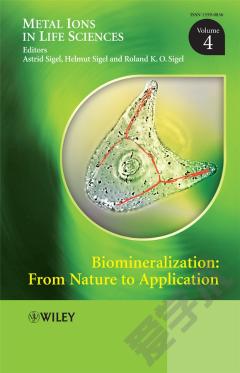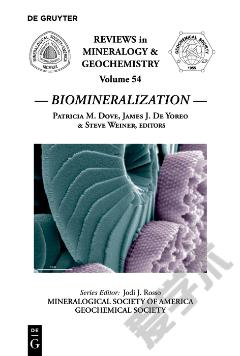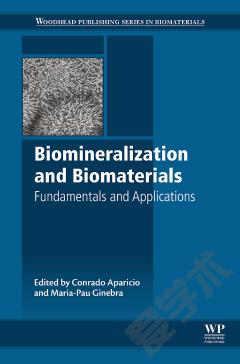Biomineralization —— From Nature to Application
----- 生物矿化:从天然到应用
Volume 4 focuses on the vibrant research area centering around Biomineralization and its role in Nature and in biomimetic applications. With nearly 2700 references, 14 tables, and more than 140 illustrations, it is an essential resource for scientists working in the wide range from material sciences and inorganic biochemistry all the way through to medicine including the clinic. In 18 stimulating chapters, written by 36 internationally recognized experts, Biomineralization. From Nature to Application highlights critically the interrelations between crystals and life. The introductory chapter "Crystals and Life" is setting the scene for the book. The "bio" in the term biomineral implies that the high activation energy (extreme temperature, pressure, etc.) commonly involved in mineral formation by strictly inorganic chemical means is bypassed by the intervention of biopolymers which alter the crystallization reaction pathways. Silicate minerals are most abundant but are restricted in the sense that the majority of silica biochemistry and biogenic siliceous mineral formation takes place in the oceans. The carbonate and phosphate cycles are more prominent in the terrestrial portion of the earth's surface as is also evidenced in several chapters of this book. The interrelation between genes or genomes and biomineralization and the role of enzymes in biomineralization processes are covered in Chapters 2 and 3. The ubiquity of prokaryotes (comprised of 'bacterial' and 'archeal' domains) is unparalleled in nature as pointed out in Chapter 4. These remarkable organisms have a metabolic plasticity and tolerance to extremes far greater than any other life form so that they are able to thrive in almost any terrestrial environment. They may form 'biofilms', i.e., matrix-covered bacterial populations that exhibit complex physicochemical and physiological characteristics, which differ in their properties from planktonic cells in the overlying aqueous phase -- and, yes, the biomineralization capacity of these minute creatures can have global effects! Organisms exercize control over their mineral parts with great fidelity. So far over 60 different minerals are identified in all five kingdoms, calcium being the main, but not only, cation in biogenic minerals. This is evident from Chapters 5 to 7 where properties of carbonate, sulfate, and oxalate biominerals are summarized. The next chapter describes biosilicification processes in diatoms. These unicellular eukaryotic microalgae have emerged as a model organism for studying composites of organic material and nanostructured silica. Chapter 9 is devoted to invertebrate tooth tissues containing large quantities of heavy metals for structural purposes. Examples include iron mineralized mollusk teeth, marine worm jaws with copper and zinc, or arthropod mandibles enriched with zinc and manganese. The next two chapters deal with biominerals in ferritins, which consist of nanoparticles formed by hydrated ferric oxide, and magnetotactic bacteria; these use magnetite or greigite in their magnetosomes which allow them to align and migrate along geomagnetic field lines, whereby each cell behaves as a self-propelled magnetic compass needle. Chapter 12 considers to what extent (bio)minerals are recorders of the past. This is a difficult question still open for debate because the role of bacteria in ancient geological formations, such as banded iron formations, is hard to establish since organic templates are rarely preserved. The dynamics of biomineralization and biodemineralization are summarized in Chapter 13, the biodemineralization reactions being discussed for tooth enamel and bone. The skeleton of vertebrates consists of a mineral phase (an analogue of the geologic mineral hydroxyapatite) and an organic phase (principally collagen). Thus, Chapter 14 describes the mineralization mechanism of collagen-based connective tissues and the following one deals with mammalian enamel formation, enamel, a hard bioceramic, being the outermost cover of teeth. Mineralized tissues such as bone, teeth, shells or glass sponges fulfill the mechanical functions of support or protection. As a consequence, these materials need to be very fracture-resistant and are therefore an ideal subject of study for biomimetic materials research as shown in Chapter 16. Similarly, the bioinspired growth of mineralized tissue, i.e., tissue engineering, the topic of Chapter 17, is an emerging discipline focused on generating tissue replacements using combinations of cells, biological molecules and materials. The terminating Chapter 18 deals with the controlled synthesis of inorganic crystals or hybrid organic-inorganic materials with specific size, shape, orientation, etc., and their incorporation into a structural hierarchy. With such building blocks new materials and devices can be designed for potential applications in diverse fields such as catalysis, medicine, electronics, ceramics or cosmetics.
{{comment.content}}








 京公网安备 11010802027623号
京公网安备 11010802027623号